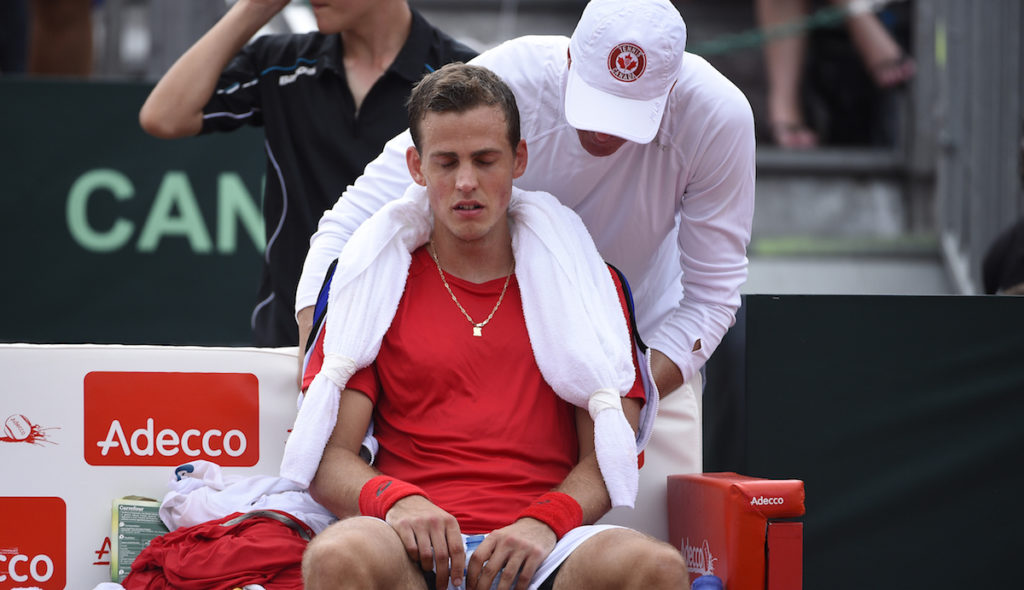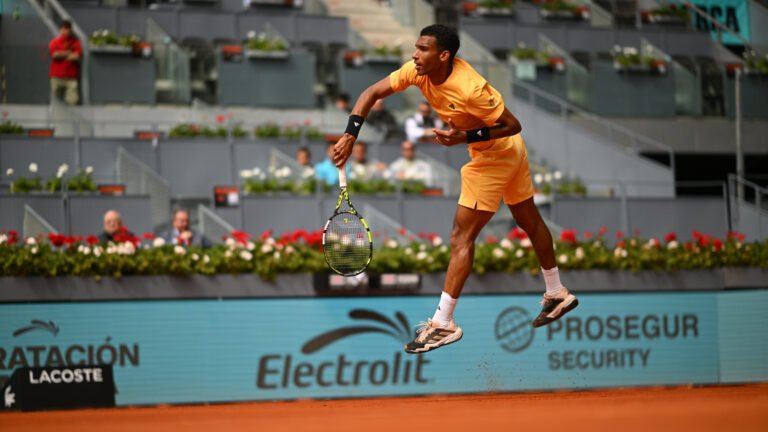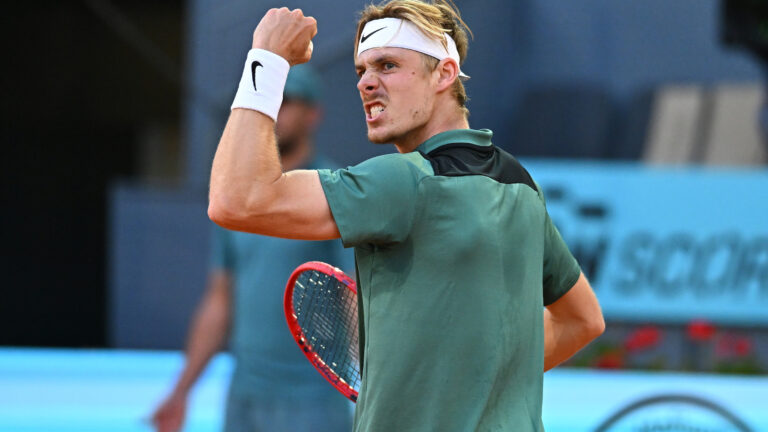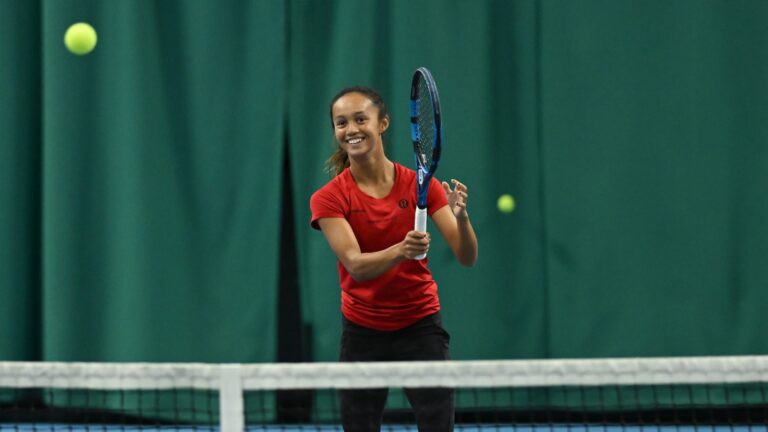
The main strategic play in Davis Cup is the host team doing all it can to stack the odds in its favour.
That was much of the story of the French team’s two singles wins on the opening day of the World Group first round against Canada on the Caribbean island of Guadeloupe on Friday.
If it wasn’t enough that there was the damp, slow red clay court and quasi-oppressive heat and humidity, dame fortune (lady luck) appeared to want no part of Canada, depriving it of the one player who could logically threaten a French team featuring four top-20 players – No. 13-ranked Milos Raonic.
Once it was learned Monday that Raonic was not over his adductor injury from the Australian Open semi-final and wasn’t available, it shaped up to be a desperate situation for an under-manned Canadian squad.
“It’s going to be hard, but we have no choice,” captain Martin Laurendeau said on the eve of Friday’s opening singles. “We’re playing guys in the top-20, so you sort of have to play the match of your life.”
Laurendeau, in his 12th year as captain and his fifth with Canada as an elite World Group nation, doubled up on a descriptive when he spoke about his players and the task at hand, “the guys know they’re real underdogs, real underdogs going in.”
The four French players are No. 9 Jo-Wilfried Tsonga, No. 10 Richard Gasquet, No. 17 Gael Monfils and No. 19 Gilles Simon. That captain Yannick Noah selected the higher ranked players for singles was no real surprise. Monfils is kind of a local favourite because his father Rufin is from Guadeloupe (his mother Sylvette is from Martinique) and Simon was the most impressive of the ‘Frenchies’ in the practice days leading in. As well, Tsonga and Gasquet are 2-0 in previous Davis Cup clay-court doubles and form a potent pair.

The opening singles between Frank Dancevic and Monfils was a mismatch on paper – with the 31-year-old Canadian now ranked No. 245 while the 29-year-old Frenchman is No. 17. So far in 2016, Dancevic had played the Australian Open qualifying and two European Futures events totaling five matches against opponents with an average ranking of No. 606. Monfils has played three tournaments, all on the main tour, against 11 opponents with an average ranking of No. 81.
On the soggy red clay, which didn’t always give the truest of bounces, Dancevic won the opening game but was broken at 1-1, the first of six breaks for Monfils. He only held one break point against the Frenchman during the match and failed to convert.

Monfils, who has a 28-10 record at Roland Garros and has reached one semi-final and three quarter-finals in Paris, looked right at home on the clay, covering it with consummate ease and frequently thwarting Dancevic’s aggressive shot-making with athletic gets and precision passing shots. The final score of the one hour and 25-minute match was 6-3, 6-1, 6-3.
“I threw everything I had at him,” Dancevic told Sportsnet after the match about his opponent Monfils, “tried some drop shots here and there and got lucky on a couple and a couple he was there and he read me. But I wasn’t going to sit back there and just rally with him from the baseline. It was one of those things where I had to go for it. I had to go for every first serve and any time I had an opportunity, I had to go for a shot. Overall, I thought he played very well out there and it was a very difficult situation for me.”
On a day when there had been dire predictions of potential showers, the first mach was completed without interruption but not without enough precipitation to have stopped a match that was played on hard courts.

Vasek Pospisil, 1-1 head-to-head going into the second match with Gilles Simon, was Canada’s best hope for a singles win on day one. The current world No. 44 could not have made a better start – bolting to a 5-0 lead. Simon was a little tentative and Pospisil made him pay with a rash of forehand outright winners and an all-round effective attacking game.
But Simon held serve to 5-1 and gradually clawed his way back as Pospisil became increasingly vulnerable. Simon eventually leveled at 5-all.
In the eleventh game with Pospisil serving and the game score at deuce, Pospisil had a sitter forehand volley and somehow mishit right back to Simon who tossed up a lob. What should have been a put-away turned into a double calamity when Pospisil proceeded to flub a make-able overhead out of court.
He was broken for the third time in a row and looked lost. Still, he pushed Simon to love-40 in the following game and seemed likely to force a tiebreak. But – and this was the story of the day – he failed to convert any of the three break points and Simon won five points in a row to wrap up the set.

The rest of the match was a brave but excruciating ordeal for Pospisil as he battled Simon and his own well-known problems playing in heat and humidity.
He went down 2-0 in the second set – a run of eight games lost in a row – but showed his guts by continuing to fight and holding serve to trail 2-1. He took breaks at the end of both the first and second sets to try to re-energize but still looked at times like he was either cramping or about to collapse with exhaustion. But he fought until the very end despite the increasingly obvious futility. The final score was 7-5, 6-3, 6-3 for Simon, with Pospisil even having two break points at 3-all in the final set – failing to convert on either on a day when he finished 2/13 on break points. Mercifully, or maybe not for Pospisil, the match was not interrupted by rain.
Time – basically until tomorrow’s doubles when he is supposed to partner with Philip Bester against Gasquet and Tsonga – will tell if he was wise to expend so much energy in attempting to make a comeback. But no one who watched his determination to give all he had, or his slumped posture in his courtside chair after the match, will not admire his determination and tenacity.
“He had a great start – 5-0 on Gilles was pretty well executed at that stage,” said Laurendeau, “then he just kind of hit a wall. He’s always worried about being dehydrated and he was drinking a lot and kind of bloated and was struggling with stomach cramps the rest of the match.
“Once he gets this feeling of complete depletion it’s very hard to be responsive at that stage.”
Joking, Laurendeau added, “he’ll probably sleep in an ice chamber tonight and see how he goes in the morning.”

The outlook is certainly not entirely rosy going into Saturday’s doubles – at 1 p.m. (EST) on Sportsnet 360 – as Pospisil is the highest ranked doubles player at No. 16 of those scheduled to play. Bester is No. 160 while Tsonga is No. 254 and Gasquet is No. 602.
Even though the results weren’t what Canadians were hoping for on day one of the best-of-five match tie, no one will dispute the effort put forth by Pospisil in the two hours and 37 minutes he was on court.
Captain Laurendeau said it best when he summed up about the gritty Pospisil, “you can’t take away his patriotism and his heart, can you.”
All about Yannick

Once Milos Raonic and Daniel Nestor withdrew from the Davis Cup World Group opening round in Guadeloupe, the hoard of French media (56-strong) there seemed to concentrate on the personality of the new captain Yannick Noah. The 55-year-old Noah gained immortality in French tennis terms by winning the 1983 Roland Garros title, the first Frenchman to do so in 37 years (a feat yet to be duplicated 33years later).
Noah has been one of the most charismatic characters in tennis in a league with others such as John Newcombe, Boris Becker, Andre Agassi, Roger Federer and Rafael Nadal.
Looking through some old magazines this week, yours truly discovered a Sports Illustrated article written two months after Noah won Roland Garros.
The picture above shows Noah in action with his dreadlocks and on the right dressed as a “Mousquetaire” – a reference to the four famous French “Mousquetaires” (René Lacoste, Henri Cochet, Jean Borotra and Jacques Brugnon) from the 1920s and 1930s.
The very beginning of the article, written by Ray Kennedy, gives a feel for just how big the Noah victory at Roland Garros was, and the kind of guy the newly-minted Grand Slam champion was at age 23:
Some 35 miles southeast of Paris, down a dusty back road that winds through lush orchards and glowing wheat fields depicted by innumerable French Impressionists, around rocky outcroppings, past rushing streams and bearing left at the first cow this side of a cluster of stone farmhouses, lies the quiet little village of Nainville-les-Roches. Quiet, that is, until one recent sultry June evening when a caravan of revelers, led by Yannick Noah at the wheel of his white Mercedes 500 SEL, rolled up to the iron gates of the Noah compound, honking and hooting like a traveling circus. So what if the neighbors’ chickens were roused from their roosts. Just a few hours earlier, on the blazing bronze clay of Roland Garros Stadium in Paris, Noah had defeated Sweden’s Mats Wilander in three sets to become the first Frenchman in 37 years to win the Championnats Internationaux de France. And zut alors, man, that called for a grande fete folle – one helluva bash.
As if signaling the end of the drought in French tennis, a fully clothed Noah promptly did a spread-eagle flip into the swimming pool, touching off a mass splash-in. When his coach, Patrice Hegelauer, begged off, Noah leaped from the pool and, shaking his Rastafarian locks like a retriever emerging from the duck pond, doused him with a whirling spray and then unceremoniously tossed him into the swim of things.
The 50 guests, including Noah’s girl friend, Jill Goodacre, a model from Boulder, Colo., actress Annie Girardot and assorted musicians, villagers and other friends, feasted on a buffet of country ham, sausages, cheeses and enough champagne to overflow the pool. Manning the microphone of a super-charged sound system set up alongside the tennis court, Noah crooned to the thumping rhythms of rock and reggae. He then joined a dancefest on the sodden lawn that turned into a variation on mud wrestling. Indefatigable to the end, at 2 a.m. the host rallied a handful of survivors and led a weaving parade back to Paris, where the party raged on until dawn in a dungeonous Left Bank disco.

Noah (pictured above with Vasek Pospisil this week) was ‘discovered’ by African-American great Arthur Ashe on a trip to Cameroon in 1971. After tipped off by Ashe, officials at the French Tennis Federation, an 11-year-old Noah was sent to Nice to train with the best French juniors.
It was never easy for him and he often thought about leaving and returning to his family in Yaoundé, but he persevered. Then there was a life-changing event when he was still a teenager.
The Sports Illustrated article described it:
While competing in a tournament in Dakkar, Senegal, he (Noah) overcame his shyness long enough to introduce himself to an attractive woman he spied in his hotel lobby. She was 28, a Paris fashion consultant on holiday. Noah was 18. He says, “After one day I was crazy about her and she was crazy about me. She was older, yes, but when you’re in love you don’t count. We were together for three years and it changed everything. I felt stronger, more confident and I wasn’t lonely anymore.
Noah’s post-career involved being both a champion Davis Cup (1991 and 1996) and Fed Cup (1997) captain and successful run as a pop singer. He has achieved revered status in his homeland and was selected the most popular “personality” in France by his fellow countrymen every year from 2005 until 2012.


